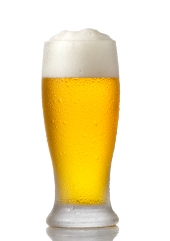Sent to you by J via Google Reader:
Krausening is a traditional German method for carbonating beers without using sugars or other adjuncts. Instead actively fermenting malt wort is added to the fermented beer to provide the malted sugars needed for carbonation.
The History of Krausening
 The "Reinheitsgebot", or German purity law, originated in Bavaria in 1516. It specifies that beer may only be made from the three basic ingredients: malt, hops, and water. Interestingly yeast was left out of the original law as it was unknown until Louis Pasteur discovered microorganisms in the late 1800's. It was recently replaced by the "Biergesetz" in 1993, which also allows the use of malted wheat and cane sugar, though the term "Reinheitsgebot" is more commonly used.
The "Reinheitsgebot", or German purity law, originated in Bavaria in 1516. It specifies that beer may only be made from the three basic ingredients: malt, hops, and water. Interestingly yeast was left out of the original law as it was unknown until Louis Pasteur discovered microorganisms in the late 1800's. It was recently replaced by the "Biergesetz" in 1993, which also allows the use of malted wheat and cane sugar, though the term "Reinheitsgebot" is more commonly used.
Since sugars were not allowed in beer, malt wort was used instead. Krausening was widely used in Germany particularly for lagers. Many lagers are cold fermented and aged, often causing the yeast to go dormant. By adding actively fermenting wort for carbonation the lager could be properly carbonated. Krausening was less commonly used in Kolsch or Alt, as these ales were fermented at warmer temperatures leaving active yeast.
Krausening
In a brewery, krausening would be done with fresh wort taken from the most recent batch made. For the homebrewer, Krausening is most often done with a small amount of wort made from dry malt extract. Alternately you can use a fresh batch of wort or keep some wort in a sterile container in the refrigerator from your last batch.
A key question is how much wort to use for proper carbonation? A good rule of thumb is that you should add enough wort to raise the gravity of the beer three points. For simplicty you can try the following formula from the Home Brewing Wiki:
Quarts_of_wort = (12 x Gallons_of_beer) / ((Specific_gravity_wort – 1.0) * 1000)
For example, if the krausening addition of wort (also called gyle) has a specific gravity of 1.060, and we're krausening 5 gallons of beer, the result would be (12 x 5)/((1.060-1)*1000) which works out to exactly one quart of wort we add at bottling.
Traditionally, the krausening addition is added at the most active point of fermentation. Ideally you should add yeast to your krausen and monitor it for active fermentation, but try to catch it before a lot of the malt sugars have been consumed. You need to measure the specific gravity of the krausening addition and do the above calculation before adding it to the wort to get the appropriate amount.
After you add the krausening wort, you can bottle or keg your beer and naturally carbonate it just as you would if you were with sugar carbonation. Store your beer in a cool, dark place for a week or two to allow it to carbonate and then lager or age as desired.
Krausening is a great way to add some variety to your beer brewing techniques, and assure that your beer is made from pure barley malt. Thanks again for joining us on the BeerSmith Home Brewing Blog. Please subscribe or retweet this article if you enjoyed it! Have a great brewing week!
- Tweet This!
- Share this on Facebook
- Stumble upon something good? Share it on StumbleUpon
- Email this to a friend?
- Digg this!
- Buzz up!
- Share this on Mixx
- Share this on del.icio.us
- Share this on Reddit
- Add this to Google Bookmarks
- Submit this story to Propeller
- Post this to MySpace
- Subscribe to the comments for this post?
- Share this on Linkedin
- Mashing for All Grain Beer Brewing
- Bottling Beer: 10 Tips for Home Brewers
- Making a Yeast Starter for your Home Brew Beer
- 5 Home Brewing Tips to Avoid the Dreaded Bottle Bomb
- Brewhouse Efficiency for All Grain Beer Brewing
Things you can do from here:
- Subscribe to BeerSmith Home Brewing Blog using Google Reader
- Get started using Google Reader to easily keep up with all your favorite sites
No comments:
Post a Comment
Babbles